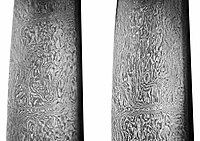
Photo from wikipedia
Discrete short steel fibres were proposed to be mixed with concrete for arresting cracks and enhancing the post-cracking resistance. It has been proven in previous tests that spiral steel fibres… Click to show full abstract
Discrete short steel fibres were proposed to be mixed with concrete for arresting cracks and enhancing the post-cracking resistance. It has been proven in previous tests that spiral steel fibres possessed markedly higher bonding to concrete matrix, leading to significantly improved performance of steel fibre reinforced concrete (SFRC) in terms of crack controllability, impact resistance, deformability and energy absorption capability. However, at the initial stage of cracking, SFRC reinforced with spiral fibres has relatively lower resistance to crack opening as compared to that reinforced with other types of steel fibres because of spiral shape stretching. To overcome this shortcoming, in the present study, short hooked-end steel fibres that exhibit high pull-out resistance at the crack initiation stage were mixed with spiral steel fibres in the normal-strength concrete matrix. A total volume fraction of 1% of hybrid steel fibres was mixed to cast SFRC specimens. With various mix ratios between spiral and hooked-end fibres considered, five batches of SFRC specimens were tested. Uniaxial compressive tests and four-point bending tests were carried out to compare the mechanical properties of SFRC materials with hybrid fibres while three-point bending tests on SFRC structural beams under static, drop-weight impact and post-impact static loading tests were conducted to investigate the structural performances. An equal dosage of hooked-end and spiral fibres was found to outperform other blend proportions to provide synergetic reinforcement to concrete matrix in terms of post-cracking resistance, energy absorption capacity and post-impact performance.
Journal Title: Advances in Structural Engineering
Year Published: 2022
Link to full text (if available)
Share on Social Media: Sign Up to like & get
recommendations!